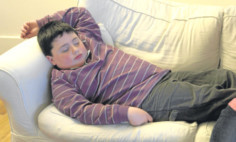
Scottish youngsters are among the least active in the western world, according to a damning new report.
Scottish youngsters are taking less exercise than ever despite warnings it will cause chronic health problems.
Experts scrutinised 32 developed countries to find out how many boys and girls take one hour’s exercise a day vital for a healthy childhood.
But despite increased awareness of the dire effects of obesity and inactivity among the young, the study revealed the number of Scots children getting enough exercise to stay healthy is at a record low.
The worrying findings have sparked calls for PE to made a compulsory subject on a par with maths or English in every school in Scotland.
Tam Fry, of the National Obesity Forum, said: “PE should be introduced as a core subject in schools.
“The Welsh Assembly is currently discussing a proposal and compulsory activity breaks in between lessons are being trialled in England. Scotland should consider both options.”
Experts recommend youngsters get an hour of moderate physical exercise a day, such as skateboarding, football or dancing, to stave off severe long-term health problems.
But the research, led by the University of St Andrews, found in 2002 25.2% of Scottish boys surveyed who were aged 11, 13 and 15, met that target but by 2010 it had plunged to 18.3%.
Scotland’s girls fared even worse with just 13.6% getting enough exercise in 2002 and even less 11% in 2010.
Dr Jo Inchley, of the Child and Adolescent Health Research Unit at the St Andrews University, said the message from the research was youngsters needed more encouragement to be active every day.
She said: “You would think that one hour of activity a day is not too difficult for children and young people but many adults do not achieve their target of 30 minutes a day.
“What has come out of this study is that Scotland is not unique and although there has been a lot of investment in this area, it shows how difficult it is to get young people to be active.”
South of the Border 28.9% of English boys met the target in 2002, but that figure dipped to 28.6% in 2010. The number of active girls decreased from 15.6% in 2002 to just 14.6% in 2010.
Of the home nations, Welsh youngsters were the only ones to buck the trend with 21.8% of boys meeting the target in 2002, which increased to 24.2% in 2010.
Similarly, 11.9% of Welsh girls exercised for an hour a day in 2002, increasing to 13.8% in 2010.
A Scottish Government spokeswoman said other studies had shown more children achieved the target when their activities were averaged across the whole week.
She said: “We welcome the most recently published Scottish Health Survey, which shows that in 2013, 75% of children met the recommended level.”
Across Britain, 25% of adults are now obese, compared with fewer than 3% in the 1970s.
It was reported last week that sugar and carbohydrates are the real culprits in the epidemic.

Enjoy the convenience of having The Sunday Post delivered as a digital ePaper straight to your smartphone, tablet or computer.
Subscribe for only £5.49 a month and enjoy all the benefits of the printed paper as a digital replica.
Subscribe